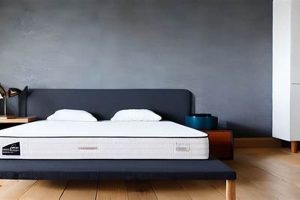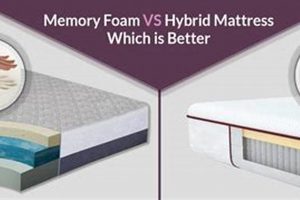Product selection often involves comparing prominent offerings within a specific category. In the realm of sleep solutions, two well-recognized options frequently considered are mattresses from Nectar and Casper. Each brand presents distinct constructions, materials, and targeted consumer preferences, factors which influence a potential buyer’s final decision.
The significance of choosing the appropriate sleep surface is multifaceted. Adequate support contributes to spinal alignment, potentially reducing back pain and promoting healthy posture. Material composition can affect temperature regulation, influencing sleep quality and comfort. Brand reputation, warranty terms, and customer reviews further inform the decision-making process, adding layers of complexity to the selection of a suitable mattress.
The subsequent sections will delve into a detailed analysis of key characteristics for each of these brands. This analysis will encompass aspects such as construction, firmness levels, temperature control, and overall value proposition, thereby providing a framework for discerning the optimal choice based on individual needs and preferences.
Selecting the optimal mattress requires careful consideration of individual sleeping preferences and needs. Comparing leading brands, like those discussed here, involves evaluating several key factors. The following points offer guidance in making an informed decision.
Tip 1: Prioritize Support and Alignment: Evaluate the core construction of each mattress. Look for features that promote spinal alignment, particularly if you experience back pain. Consider the firmness level and how it corresponds to your preferred sleeping position (side, back, or stomach).
Tip 2: Assess Material Composition: Understand the materials used in each mattress. Memory foam, latex, and innerspring coils each offer distinct comfort and support characteristics. Consider potential allergens or sensitivities when evaluating material choices.
Tip 3: Analyze Temperature Regulation: Temperature regulation is crucial for a comfortable sleep environment. Some materials, like gel-infused memory foam or breathable latex, are designed to dissipate heat effectively. Consider your typical sleeping temperature when making a choice.
Tip 4: Review Firmness Ratings: Firmness is subjective, but standardized ratings (e.g., soft, medium, firm) can provide a general guideline. Research customer reviews to gauge the accuracy of the manufacturer’s firmness claims and how they align with real-world experiences.
Tip 5: Examine Warranty and Trial Periods: A generous warranty and a risk-free trial period offer valuable protection. These allow you to test the mattress in your own home and ensure it meets your expectations. Carefully review the terms and conditions of each warranty and trial period.
Tip 6: Consider Motion Isolation: If sharing a bed, motion isolation is essential to minimize sleep disturbances. Memory foam mattresses typically excel at absorbing motion, while innerspring mattresses may transfer more movement.
Tip 7: Read Independent Reviews: Seek out objective reviews from reputable sources. Avoid relying solely on marketing materials from the manufacturers. Look for detailed evaluations that address both the pros and cons of each mattress.
In summary, a considered approach to mattress selection incorporates a thorough understanding of construction materials, firmness levels, temperature regulation, and motion isolation. Prioritizing these factors, alongside a review of warranty and trial periods, significantly increases the likelihood of selecting a mattress that provides optimal comfort and support.
The subsequent conclusion will consolidate the key insights presented and offer final considerations for making an informed purchasing decision.
1. Construction Materials
The composition of internal components significantly impacts a mattress’s performance, longevity, and suitability for individual sleepers. Examining the materials used in mattresses is a fundamental step when considering options from different manufacturers.
- Core Composition
The primary support structure dictates overall firmness and stability. Nectar mattresses commonly feature a memory foam core, designed to contour to the body and minimize pressure points. Casper mattresses often employ a hybrid design, combining layers of foam with an innerspring coil system. The core material influences factors such as motion transfer and long-term durability.
- Comfort Layers
The uppermost layers contribute to immediate comfort and pressure relief. Variations exist in the type and density of foam used. Some manufacturers incorporate gel infusions or open-cell structures to enhance breathability. The specific arrangement of comfort layers affects the initial feel of the mattress and its ability to regulate temperature.
- Cover Fabric
The outer cover impacts breathability, surface texture, and resistance to wear and tear. Materials such as cotton, polyester blends, and specialized performance fabrics are commonly used. The cover’s construction affects airflow and can contribute to moisture-wicking properties, influencing the overall sleeping experience.
- Fire Retardant Barriers
Federal regulations mandate that mattresses include fire retardant barriers. These barriers, often made from materials like silica or treated rayon, are designed to slow the spread of fire. The type and placement of these barriers can influence the overall feel and breathability of the mattress.
Variations in the construction materials used by mattress manufacturers lead to distinct performance characteristics. A comprehensive assessment of these materials, including their density, composition, and arrangement, is essential for informed decision-making. Considerations such as off-gassing potential and material sourcing may also be relevant for some consumers.
2. Firmness Level
Firmness level is a crucial determinant in the selection of a mattress and represents a tangible point of differentiation between mattress options. When evaluating Nectar mattresses against Casper mattresses, firmness serves as a key factor influencing spinal alignment, pressure relief, and overall sleep quality. Variations in firmness stem from differences in internal construction, material density, and layering techniques employed by each manufacturer.
Nectar mattresses, typically constructed with memory foam, are often perceived as offering a conforming, cradling feel. This characteristic is advantageous for side sleepers who require pressure relief in the shoulders and hips. Conversely, Casper mattresses, especially those with hybrid constructions incorporating both foam and innerspring coils, tend to exhibit a more responsive, balanced feel. This attribute is favored by individuals who change sleeping positions frequently or prefer a firmer surface for back or stomach sleeping. The incorrect firmness level can lead to discomfort, pain, and disrupted sleep. For instance, a mattress that is too soft may not provide adequate support for heavier individuals, while a mattress that is too firm can create pressure points for lighter individuals.
Understanding the relationship between firmness level and individual sleeping preferences is paramount when making a mattress purchase. Consideration should be given to body weight, sleeping position, and any existing musculoskeletal conditions. Evaluating firmness ratings alongside user reviews and trial periods can aid in selecting a mattress that provides optimal support and comfort. Ultimately, the appropriateness of a particular firmness level is subjective and depends on aligning individual needs with the specific characteristics of each mattress.
3. Temperature Regulation
Temperature regulation significantly impacts sleep quality, and is a critical factor when evaluating mattresses. A mattress’s ability to dissipate heat and maintain a comfortable sleeping temperature directly affects sleep duration and restorative properties. When comparing Nectar and Casper mattresses, temperature regulation is influenced by the materials used and their construction methods.
Nectar mattresses, primarily constructed from memory foam, are often cited as potentially retaining more heat compared to alternatives. Traditional memory foam can restrict airflow, leading to increased body temperature during sleep. To address this, Nectar incorporates features such as gel-infused memory foam and breathable covers, aimed at mitigating heat retention. In contrast, Casper mattresses, particularly hybrid models combining foam and innerspring coils, generally exhibit better airflow due to the coil system. This can result in improved temperature regulation compared to all-foam constructions. For example, an individual living in a warmer climate might find a Casper hybrid mattress more conducive to comfortable sleep due to its enhanced breathability. Conversely, someone residing in a colder region might not perceive the same level of difference or may even prefer the heat-retention qualities of memory foam.
Therefore, when assessing Nectar and Casper mattresses, individuals should consider their typical sleeping temperature and environmental conditions. While both brands incorporate features designed to address temperature regulation, the inherent properties of their core materials and construction methods result in differing thermal performance. The practical significance of understanding these differences lies in selecting a mattress that promotes optimal sleep quality by maintaining a comfortable and consistent body temperature throughout the night. Failure to consider temperature regulation can lead to disrupted sleep, increased tossing and turning, and a reduction in the restorative benefits of sleep.
4. Motion Isolation
Motion isolation, the ability of a mattress to minimize the transfer of movement from one area to another, is a crucial consideration, particularly for couples or individuals sharing a bed with pets. This attribute directly impacts sleep quality, as minimized motion transfer reduces the likelihood of disturbances caused by a partner’s movements. When considering mattress selection, motion isolation serves as a tangible differentiator, with varying levels of performance among different mattress types. Within the specific context of Nectar versus Casper mattresses, motion isolation capabilities are significantly influenced by the construction and materials employed by each brand. For example, a partner tossing and turning on a mattress with poor motion isolation may awaken the other individual, disrupting sleep cycles and reducing overall sleep quality. Conversely, a mattress with superior motion isolation can effectively dampen movement, allowing both individuals to sleep undisturbed.
Nectar mattresses, generally constructed with memory foam, tend to excel in motion isolation due to the material’s inherent properties. Memory foam absorbs movement, preventing it from propagating across the mattress surface. This is particularly beneficial for couples where one partner is a light sleeper or tends to move frequently during the night. Casper mattresses, especially those with hybrid designs incorporating both foam and innerspring coils, typically offer less effective motion isolation compared to all-foam models. While the foam layers in a Casper mattress contribute to some degree of motion dampening, the innerspring coil system can transmit movement more readily. Therefore, while one partner gets out of bed on a Casper hybrid, the other may feel the motion due to the interconnected springs system. This transfer depends on the design of the innerspring system and the density of the overlying foam layers.
In summary, motion isolation is a critical performance characteristic influencing sleep quality. Nectar mattresses, with their memory foam construction, generally offer superior motion isolation compared to Casper mattresses, particularly hybrid models. Individuals sharing a bed should prioritize motion isolation when selecting a mattress to minimize sleep disturbances caused by a partner’s movements. Careful consideration of construction materials and design features is essential for making an informed decision aligned with individual sleep needs and preferences.
5. Edge Support
Edge support, the structural reinforcement along the perimeter of a mattress, affects its usable surface area and overall stability. This characteristic is particularly relevant when comparing mattress brands, as variations in edge support influence both comfort and longevity. Specifically, edge support impacts whether a user can comfortably sit on the edge of the bed or utilize the full surface area without experiencing excessive compression or roll-off.
- Sitting Support
The ability of a mattress edge to provide stable support while sitting is a primary function of edge reinforcement. Strong edge support prevents the edge from collapsing excessively under weight, providing a secure and comfortable seating surface. For instance, individuals who frequently sit on the edge of their bed to dress or read benefit from robust edge support. In the context of Nectar versus Casper mattresses, different construction methods result in varying degrees of sitting support. Mattresses with reinforced edges maintain their shape and prevent premature wear, while those lacking adequate support may exhibit sagging over time.
- Sleeping Surface Maximization
Effective edge support maximizes the usable sleeping surface of a mattress. Without adequate reinforcement, the edges may compress under body weight, reducing the area available for comfortable sleep. This is particularly important for couples or individuals who prefer to sleep near the edge of the bed. In the context of Nectar versus Casper mattresses, the presence or absence of edge support directly impacts the available sleeping space. Mattresses with strong edge support allow sleepers to utilize the entire surface area without feeling as though they might roll off, thereby enhancing comfort and sleep quality.
- Structural Integrity and Longevity
Edge support contributes to the overall structural integrity and longevity of a mattress. Reinforced edges prevent sagging and maintain the mattress’s shape over time, extending its lifespan. This is particularly important for mattresses subjected to regular use and weight. When comparing Nectar versus Casper mattresses, the quality of edge support influences the mattress’s ability to withstand wear and tear. Mattresses with robust edge support are less prone to developing soft spots or indentations along the perimeter, ensuring consistent support and comfort throughout their lifespan.
Variations in edge support between different mattress models are a key consideration for potential buyers. A mattress with strong edge support offers enhanced stability, maximizes the usable sleeping surface, and contributes to long-term durability. When selecting between Nectar and Casper mattresses, evaluating edge support characteristics helps determine which mattress best aligns with individual needs and preferences, particularly those related to comfort, stability, and longevity.
6. Price Point
Price point represents a significant determinant in consumer purchasing decisions. Within the mattress market, specifically when contrasting Nectar and Casper mattresses, pricing considerations extend beyond the initial cost, encompassing factors such as long-term value, financing options, and promotional offers.
- Initial Investment and Budget Considerations
The upfront cost is the initial factor most consumers consider. Nectar and Casper mattresses occupy a similar price bracket, often positioning themselves as mid-range options. However, variations exist based on mattress size, model (e.g., all-foam vs. hybrid), and any ongoing promotions. Budget constraints directly influence which model, if any, falls within a consumer’s acceptable spending range. For example, a consumer with a limited budget may opt for a smaller-sized Nectar mattress over a larger, more expensive Casper hybrid.
- Long-Term Value and Durability
While the initial price is important, the long-term value depends on the mattress’s lifespan and durability. A higher-priced mattress that lasts significantly longer may prove more economical over time than a cheaper option requiring earlier replacement. Factors such as material quality, construction techniques, and warranty coverage contribute to long-term value. A Casper mattress, due to its hybrid construction, may offer increased durability compared to an all-foam Nectar model, thereby influencing its overall value proposition.
- Financing Options and Payment Plans
Many mattress companies offer financing options or payment plans to make their products more accessible to consumers. These options can spread the cost of the mattress over several months or years, potentially making a higher-priced model more manageable. The availability and terms of financing plans can influence purchasing decisions. A consumer might choose a slightly more expensive Casper mattress if attractive financing options are available, compared to a Nectar mattress with less favorable payment terms.
- Promotional Offers and Discounts
Mattress companies frequently offer promotional discounts, seasonal sales, and bundled deals to attract customers. These offers can significantly impact the effective price of a mattress. Comparing current promotions offered by Nectar and Casper is crucial for determining the most cost-effective option at a given time. For instance, a bundled offer including pillows and sheets with a Nectar mattress could offset a slightly higher initial price compared to a Casper mattress without such an offer.
In summary, the price point consideration in the Nectar versus Casper mattress comparison encompasses more than just the sticker price. Long-term value, financing options, and promotional offers contribute significantly to the overall cost. Consumers should carefully evaluate these factors to determine which mattress offers the best balance of cost and value based on their individual needs and financial circumstances.
Frequently Asked Questions
The following section addresses commonly asked questions regarding the comparison of sleep surfaces from Nectar and Casper. The information presented aims to provide clarity and facilitate informed decision-making.
Question 1: What are the primary construction differences between Nectar and Casper mattresses?
Nectar mattresses typically utilize all-foam construction, often incorporating multiple layers of memory foam. Casper mattresses commonly feature a hybrid design, combining foam layers with an innerspring coil system for enhanced support and responsiveness.
Question 2: How do Nectar and Casper mattresses compare in terms of firmness levels?
Nectar mattresses generally offer a medium-firm feel, conforming closely to the body. Casper mattresses exhibit a broader range of firmness options, including models designed for a more balanced or firmer sleeping experience.
Question 3: Which brand, Nectar or Casper, offers superior temperature regulation?
Casper mattresses, particularly hybrid models, tend to provide better airflow and temperature regulation due to the presence of innerspring coils. Nectar mattresses incorporate features like gel-infused foam to mitigate heat retention, but may not offer the same level of breathability as Casper.
Question 4: How do Nectar and Casper mattresses perform in terms of motion isolation?
Nectar mattresses, with their all-foam construction, typically excel in motion isolation, minimizing the transfer of movement across the mattress surface. Casper mattresses, especially hybrid models, may exhibit greater motion transfer due to the innerspring coil system.
Question 5: What are the key considerations regarding edge support for Nectar and Casper mattresses?
Edge support varies between models from both brands. Mattresses with reinforced edges offer greater stability and prevent excessive compression along the perimeter, maximizing the usable sleeping surface.
Question 6: How do the warranty and trial periods compare between Nectar and Casper?
Both Nectar and Casper offer warranty coverage and trial periods. Specific terms and conditions may vary, requiring careful review of the manufacturer’s policies prior to purchase. Reviewing the specific details is essential for making an informed decision.
In summary, understanding the construction differences, firmness levels, temperature regulation capabilities, motion isolation properties, edge support, and warranty terms is crucial when evaluating Nectar versus Casper mattresses. This information enables consumers to select the mattress best suited to their individual needs and preferences.
The following section will present a concluding summary, consolidating the key insights and providing final recommendations for selecting the optimal mattress.
Concluding Remarks
This exploration of nectar mattress vs casper mattress has illuminated critical distinctions across construction materials, firmness, temperature regulation, motion isolation, edge support, and price points. Each brand presents a unique combination of these attributes, catering to varied sleep preferences and individual needs. Nectar’s memory foam construction typically provides enhanced motion isolation, while Casper’s hybrid models often offer improved airflow. These variations necessitate a comprehensive evaluation to determine the most suitable option. Careful consideration of these properties aids individuals in making an informed choice.
The ultimate decision regarding mattress selection rests on aligning specific requirements with the documented characteristics of each product. Thoroughly assessing personal sleep preferences and prioritizing key attributes is essential for a successful outcome. Continuing research into evolving mattress technologies and materials remains crucial for optimizing sleep quality and overall well-being in the future.


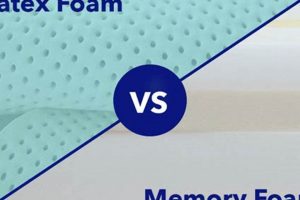
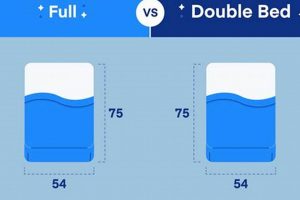
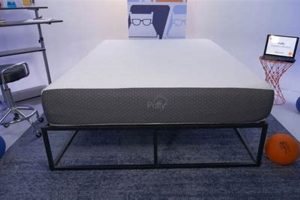
![Choosing Innerspring vs Memory Foam Mattress? [Guide] Organic & Natural Mattress Buyer’s Guide: Non-Toxic Sleep Solutions Choosing Innerspring vs Memory Foam Mattress? [Guide] | Organic & Natural Mattress Buyer’s Guide: Non-Toxic Sleep Solutions](https://mattressworldpa.com/wp-content/uploads/2025/07/th-1100-300x200.jpg)
